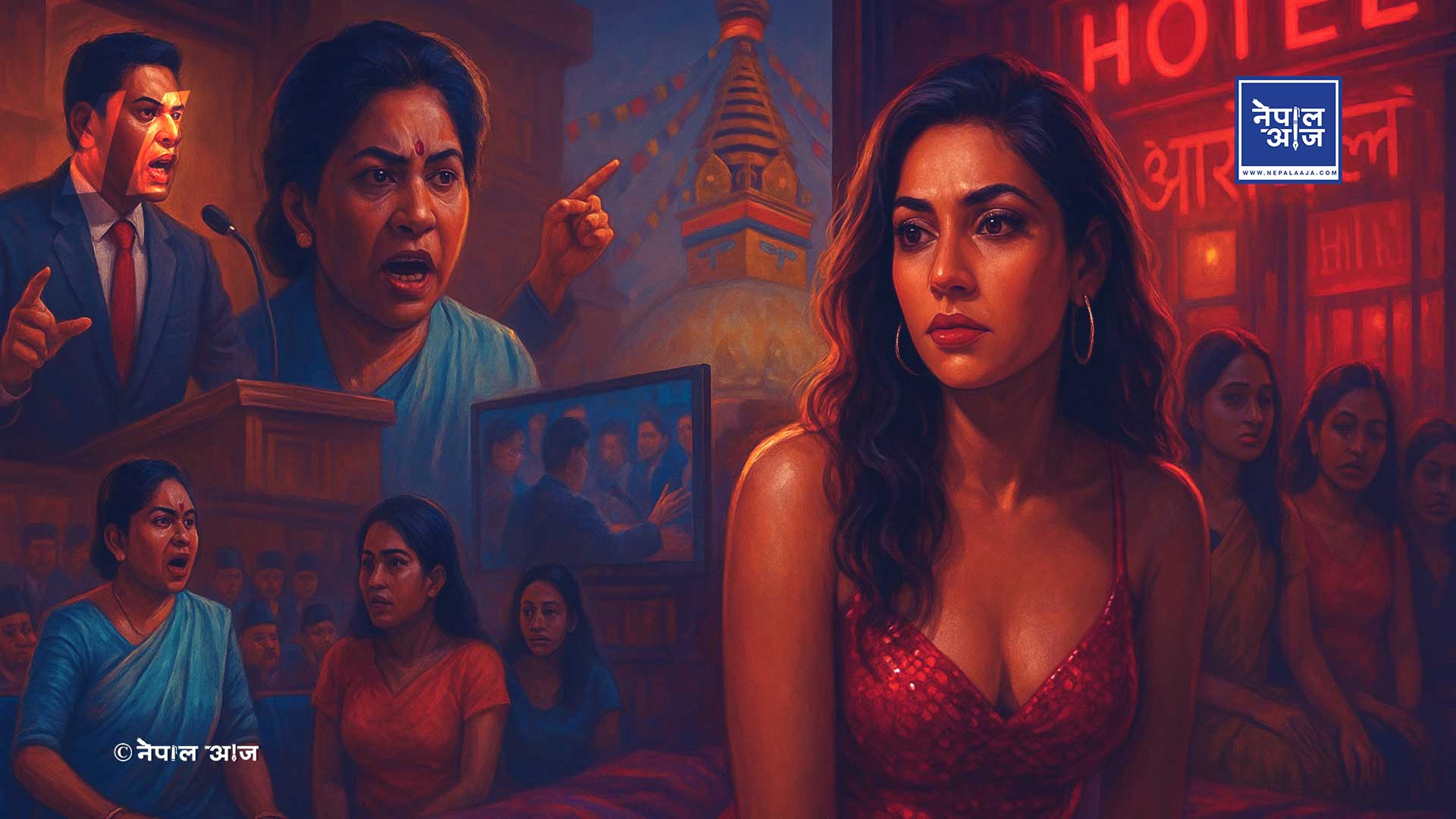The Forgotten Women of the Himalayas: Nepal’s Sex Trade Crosses Every Border

By Biken K. Dawadi | Nepal Aaja Investigative Desk
With reporting from Rukamanee Maharjan, Violeta Santos Moura and Zeeshan Jawed
Kathmandu — Nepal’s simmering political, moral, and economic tensions over prostitution erupted in Parliament this March after Nepali Congress Chief Whip Shyam Kumar Ghimire argued that legalizing sex work and cannabis could “boost the tourism economy.” His remarks—delivered during debate on the Substitution Bills—sparked outrage across party lines and ignited one of the most polarizing conversations since the Gen-Z protest movement began reshaping Nepali politics.
“Who gave him the right to express such a poor opinion against the values of Nepali society in this dignified house?” thundered CPN-UML lawmaker Rukmini Koirala, demanding a formal apology. Lawmakers Durga Rai and Deepak Singh accused Ghimire of “undermining Nepal’s cultural fabric,” arguing that a republic founded on equality was never meant to legalize brothels. Ghimire stood by his position, calling his statement “purely economic, not moral,” and citing Colorado’s cannabis tourism model as precedent.
Beneath the outrage lies a harder truth: Nepal’s sex-trade industry already thrives underground. Although no law explicitly bans sex work, the Human Trafficking and Transportation (Control) Act 2007 and the Criminal Code 2017criminalize nearly every related act—from soliciting to providing space for sex. The result is a legal paradox where enforcement often targets women in poverty rather than organized traffickers.
One such woman is Rekha*, 33, a single mother of three in Kathmandu. “Before this, my children went hungry. Now I can at least buy rice,” she said. Married at 14 and abandoned by her husband, she turned to sex work eleven years ago out of desperation. Her story reflects a common reality in Nepal’s informal economy—where survival frequently masquerades as crime.
Data on the trade remain scarce, but a Frontier Research (2015) study estimated between 24,000 and 28,000 female sex workers nationwide—rising to over 50,000 by 2020. Analysts attribute the surge to pandemic-driven job losses. The shift to mobile and social-media-based transactions has made the trade more hidden, reducing reliance on brokers but complicating regulation and outreach.
Beyond Kathmandu, Nepal’s open border with India has long served as a conduit for trafficking. Reporting by Violeta Santos Moura (Al Jazeera, 2020) found that since the 2015 earthquake, the 1,758-kilometre frontier has become one of the world’s busiest human-trafficking corridors. An estimated 12,000 Nepali children are trafficked to India each year for sexual exploitation or forced labor, and 11,000 to 13,000 girls and women—many underage—are trapped in dance bars and massage parlours within Nepal itself. The global human-trafficking industry is worth over $150 billion annually, with roughly 54 Nepali women crossing into India every day.
Legal scholar Rukamanee Maharjan attributes the crisis to Nepal’s entrenched patriarchy and economic inequality. “In many villages, daughters are still seen as financial burdens,” she said. “Families accept job offers that end in brothels.” According to the National Human Rights Commission (NHRC), around 35,000 Nepalis have been trafficked and 1.5 million remain at risk. Attempts to restrict female migration for safety reasons have, paradoxically, pushed many women into illegal and more dangerous routes, where confiscated passports and sexual violence are common.
Hundreds of kilometres away, in Kolkata’s red-light district of Bowbazar, the impact of Nepal’s domestic instability is visible daily. Zeeshan Jawed (The Times of India, 2025) reported that Nepali women trafficked there follow news of Kathmandu’s protests on flickering TV sets, fearing for families back home.
“I’m proud of our youth marching for change,” said Rita*, 34, who was trafficked to Bowbazar twelve years ago. “But when Nepal shuts down, my mother has no money, and I must work more here.” Another, Anita*, 42, said, “This turmoil makes our dream of returning home even more distant.” NGOs in Sonagachhi warn that continued political unrest and curfews in Nepal could push more women into Indian brothels, where communication blackouts already isolate them from their families.
Inside Nepal, the national conversation is gradually shifting—from rescue to rights. Groups like Shakti Samuha, founded by survivor Chari Maya Tamang (recipient of the 2013 Ramon Magsaysay Award), and Maiti Nepal continue to focus on rehabilitation and legal aid. Meanwhile, networks such as SWAN and Jagriti Mahila Mahasangh call for decriminalization rather than full legalization, arguing that safety and privacy—not state-run red-light zones—should define reform.
“Decriminalization would let us work without fear,” said Meena*, 45. “Right now, both the clients and the police can exploit us because the law protects neither.”
The Ministry of Home Affairs declined to comment on whether it plans to review the HTTCA, but officials privately admit the law’s conflation of trafficking with consensual sex work remains “confusing in application.” International institutions including UNAIDS and Amnesty International endorse Nepal’s civil-society push for decriminalization, citing links to improved public health outcomes and compliance with the UN Palermo Protocol, which Nepal ratified in 2011.
Still, for most women trapped in this moral and legal crossfire, reform feels distant. Bijaya Dhakal, widowed at 17 and now a cancer survivor, recently published her memoir Bijayi (Victorious) to remind Nepalis that endurance is not the same as consent. “Economic desperation drives choices we never wanted,” she told Nepal Aaja. “See survival for what it is—not sin.”
As lawmakers argue and borders tighten, the line between law, livelihood, and loss grows ever thinner. From Kathmandu’s neon-lit alleys to Kolkata’s dim corridors, the voices of Nepali women trapped in the shadows ask a question neither government has answered: will South Asia keep punishing its poorest women for surviving—or finally protect them as citizens with rights, health, and dignity?
Prostitution Red-Light



![From Kathmandu to the World: How Excel Students Are Winning Big [Admission Open]](https://www.nepalaaja.com/img/70194/medium/excel-college-info-eng-nep-2342.jpg)
